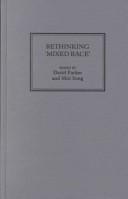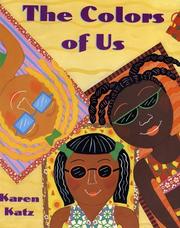| Listing 1 - 10 of 80 | << page >> |
Sort by
|

ISBN: 1849640688 0585425752 9781849640688 9780585425757 0745315674 9780745315676 0745315720 9780745315720 Year: 2001 Publisher: London ; Sterling, Va. : Pluto Press,
Abstract | Keywords | Export | Availability | Bookmark
 Loading...
Loading...Choose an application
- Reference Manager
- EndNote
- RefWorks (Direct export to RefWorks)
Exploring the complexities of mixed race in Britain and the USA, Rethinking 'Mixed Race' offers a broader and more pluralistic approach to the discussion.
Racially mixed people. --- Bi-racial people --- Biracial people --- Interracial people --- Mixed race people --- Mixed-racial people --- Mulattoes --- Multiracial people --- Peoples of mixed descent --- Ethnic groups --- Miscegenation --- Multiracial people.
Book
ISBN: 1443898996 9781443898997 1443890790 9781443890793 Year: 2016 Publisher: Newcastle upon Tyne, England : Cambridge Scholars Publishing,
Abstract | Keywords | Export | Availability | Bookmark
 Loading...
Loading...Choose an application
- Reference Manager
- EndNote
- RefWorks (Direct export to RefWorks)
Racially mixed people --- Bi-racial people --- Biracial people --- Interracial people --- Mixed race people --- Mixed-racial people --- Mulattoes --- Multiracial people --- Peoples of mixed descent --- Ethnic groups --- Miscegenation --- Language.
Book
ISBN: 9781680030198 1680030191 9781680030181 1680030183 Year: 2015 Publisher: Huntsville, Texas : Texas Review Press,
Abstract | Keywords | Export | Availability | Bookmark
 Loading...
Loading...Choose an application
- Reference Manager
- EndNote
- RefWorks (Direct export to RefWorks)
Racially mixed people --- Bi-racial people --- Biracial people --- Interracial people --- Mixed race people --- Mixed-racial people --- Mulattoes --- Multiracial people --- Peoples of mixed descent --- Ethnic groups --- Miscegenation

ISBN: 0745315674 0745315720 Year: 2001 Publisher: London Pluto
Abstract | Keywords | Export | Availability | Bookmark
 Loading...
Loading...Choose an application
- Reference Manager
- EndNote
- RefWorks (Direct export to RefWorks)
Racially mixed people. --- #SBIB:39A6 --- Racially mixed people --- Bi-racial people --- Biracial people --- Interracial people --- Mixed race people --- Mixed-racial people --- Mulattoes --- Multiracial people --- Peoples of mixed descent --- Ethnic groups --- Miscegenation --- Etniciteit / Migratiebeleid en -problemen
Book
ISBN: 0822986175 9780822986171 9780822965602 0822965607 Year: 2018 Publisher: Pittsburgh, Pa. : University of Pittsburgh Press,
Abstract | Keywords | Export | Availability | Bookmark
 Loading...
Loading...Choose an application
- Reference Manager
- EndNote
- RefWorks (Direct export to RefWorks)
Set against the backdrop of the Obama presidency, Julian Randall's Refuse documents a young biracial man's journey through the mythos of Blackness, Latinidad, family, sexuality and a hostile American landscape. Mapping the relationship between father and son caught in a lineage of grief and inherited Black trauma, Randall conjures reflections from mythical figures such as Icarus, Narcissus and the absent Frank Ocean. Not merely a story of the wound but the salve, Refuse is a poetry debut that accepts that every song must end before walking confidently into the next music
Bisexuality --- African Americans --- Men, Black --- Racially mixed people --- Bi-racial people --- Biracial people --- Interracial people --- Mixed race people --- Mixed-racial people --- Mulattoes --- Multiracial people --- Peoples of mixed descent --- Ethnic groups --- Miscegenation --- Black men --- Bi-sexuality --- Sexual orientation --- Homosexuality

ISBN: 9780805071634 0805071636 Year: 2012 Publisher: New York Square Fish
Abstract | Keywords | Export | Availability | Bookmark
 Loading...
Loading...Choose an application
- Reference Manager
- EndNote
- RefWorks (Direct export to RefWorks)
Een vrolijk (Engelstalig) prentenboek over de schoonheid van culturele diversiteit. Als Lena een zelfportret wil schilderen, legt haar moeder uit hoe ze verf kan mengen om het "juiste bruin" te verkrijgen. "Bruin is bruin" beweert Lena, waarop haar moeder met haar gaat wandelen om te tonen hoeveel verschillende tinten bruin er zijn. Terwijl ze de buren groeten, beschrijft ze hun huidskleur aan de hand van etenswaren. Lena beseft dat elke kleur mooi is. Ze schildert de portretten van al haar vrienden en gebruikt verschillende kleuren om hun huidskleur weer te geven.
Huidkleur --- Racially mixed people --- Sociology of culture --- Didactics of social education --- Primary education --- Bi-racial people --- Biracial people --- Interracial people --- Mixed race people --- Mixed-racial people --- Mulattoes --- Multiracial people --- Peoples of mixed descent --- Ethnic groups --- Miscegenation
Book
ISBN: 9781108773751 9781108489041 1108802567 1108808492 1108773753 Year: 2023 Publisher: Cambridge : Cambridge University Press,
Abstract | Keywords | Export | Availability | Bookmark
 Loading...
Loading...Choose an application
- Reference Manager
- EndNote
- RefWorks (Direct export to RefWorks)
Drawing on multinational oral history and archival research, Rachel Jean-Baptiste investigates the fluctuating identities of multiracial people, or 'métis' in colonial French Africa. Offering a nuanced history of race-making, belonging, and rights, she shows how mťis carved out varied visions of belonging in Africa, Europe, and internationally.
Racially mixed people --- History --- Race identity --- Bi-racial people --- Biracial people --- Interracial people --- Mixed race people --- Mixed-racial people --- Mulattoes --- Multiracial people --- Peoples of mixed descent --- Ethnic groups --- Miscegenation --- Africa, French-speaking
Book
ISBN: 9782707139825 2707139823 Year: 2007 Volume: *4 Publisher: Paris : Découverte,
Abstract | Keywords | Export | Availability | Bookmark
 Loading...
Loading...Choose an application
- Reference Manager
- EndNote
- RefWorks (Direct export to RefWorks)
Pendant la colonisation française, des dizaines de milliers d'enfants sont nés d'" Européens " et d'" indigènes ". Souvent illégitimes, non reconnus puis abandonnés par leur père, ces métis furent perçus comme un danger parce que leur existence brouillait la frontière entre " citoyens " et " sujets " au fondement de l'ordre colonial. Leur situation a pourtant varié : invisibles en Algérie, ils ont été au centre des préoccupations en Indochine. La " question métisse " a également été posée à Madagascar, en Afrique et en Nouvelle-Calédonie. Retraçant l'histoire oubliée de ces enfants de la colonie, cet ouvrage révèle une face cachée, mais fondamentale, de l'histoire de l'appartenance nationale en France : il montre comment les tentatives d'assimilation des métis ont culminé, à la fin des années 1920, avec des décrets reconnaissant la citoyenneté à ceux qui pouvaient prouver leur " race française ". Aux colonies, la nation se découvrait sous les traits d'une race. Cette législation bouleversa le destin de milliers d'individus, passant soudainement de la sujétion à la citoyenneté : ainsi, en Indochine, en 1954, 4 500 enfants furent séparés de leur mère et " rapatriés " en tant que Français. Surtout, elle introduisait la race en droit français, comme critère d'appartenance à la nation. Cela oblige à revoir le " modèle républicain " de la citoyenneté, fondé sur la figure d'un individu abstrait, adhérent volontaire à un projet politique commun et à souligner les liens entre filiation, nationalité et race.
Racially mixed people --- Miscegenation --- Métis --- Métissage --- Colonies --- History --- Histoire --- France --- History. --- Hybridity of races --- Racial amalgamation --- Racial crossing --- Race relations --- Bi-racial people --- Biracial people --- Interracial people --- Mixed race people --- Mixed-racial people --- Mulattoes --- Multiracial people --- Peoples of mixed descent --- Ethnic groups --- Métis --- Métissage --- Colonies&delete& --- Nationalité --- Citoyenneté --- Statut juridique --- Miscegenation (Racist theory)
Book
ISBN: 9783034316057 9783035202953 Year: 2015 Publisher: Bern Peter Lang
Abstract | Keywords | Export | Availability | Bookmark
 Loading...
Loading...Choose an application
- Reference Manager
- EndNote
- RefWorks (Direct export to RefWorks)
Ces seize textes étudient les conditions d'unions interculturelles, dans les sociétés coloniales, qui ont provoqué l'apparition de nouvelles générations métisses, ainsi qu'un phénomène de créolisation. Ils examinent le contexte et les circonstances dans lesquels ces populations se sont mélangées et la position des métis dans les nouvelles sociétés, du Canada à la Bolivie, de l'Algérie à l'Angola. ©Electre 2015
Intercountry marriage --- Mariage interethnique --- Miscegenation --- Interracial marriage --- Racially mixed people --- 392.4/.5 "05/17" --- Bi-racial people --- Biracial people --- Interracial people --- Mixed race people --- Mixed-racial people --- Mulattoes --- Multiracial people --- Peoples of mixed descent --- Ethnic groups --- Intermarriage --- Hybridity of races --- Racial amalgamation --- Racial crossing --- Race relations --- Colonies --- Verloving. Huwelijk. Huwelijksgebruiken. Partnerkeuze. Polyandrie. Polygamie. Monogamie--Nieuwe Tijd --- Conferences - Meetings
Book
ISBN: 9726722624 9789726722625 Year: 1989 Publisher: Lisboa Instituto de investigaçao cientifica tropical
Abstract | Keywords | Export | Availability | Bookmark
 Loading...
Loading...Choose an application
- Reference Manager
- EndNote
- RefWorks (Direct export to RefWorks)
Racially mixed people --- History. --- Social conditions. --- Bi-racial people --- Biracial people --- Interracial people --- Mixed race people --- Mixed-racial people --- Mulattoes --- Multiracial people --- Peoples of mixed descent --- History --- Social conditions --- Ethnic groups --- Miscegenation --- Racially mixed people - Senegambia - History. --- Racially mixed people - Senegambia - Social conditions.
| Listing 1 - 10 of 80 | << page >> |
Sort by
|

 Search
Search Feedback
Feedback About UniCat
About UniCat  Help
Help News
News